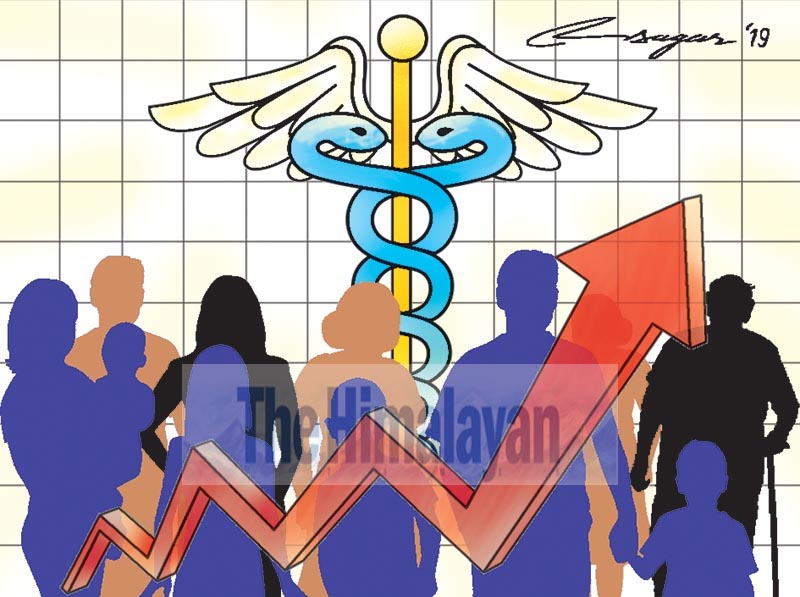Global Action Plan: Roadmap to achieve health goals
Nepal recently decided, at the health ministry level, to pilot the Global Action Plan and has formed task forces and a working committee to develop a Country Action Plan for its implementation
The Sustainable Development Goals (SDGs) are seen as the key to changing human life for the better. As global resources get accumulated in a few corporate bodies in the neoliberal economy, SDGs are believed to bring equitable prosperity with justice. Despite the unfinished agendas of the Millennium Development Goals (MDG) in many developing countries, the international community is optimistic the SDGs are within our reach. From the window of health, the SDGs are the third edition of global commitment - after Health for All by 2000 and Millennium Development Goals by 2015 - to deliver health care to all. The attainment of the health goals is not merely to achieve SDG 3, they are instrumental in attaining the other SDGs as well.
Progress in health over the last few decades has been deeply cherished by the global community. While appreciating the achievements in improving the health indicators of billions of people, it is admitted that the pace of the progress is not fast enough to accomplish the SDG goals in health. Fragmentation, duplication and inefficiency have been identified as the underlying factors undermining progress. Unless efforts are amplified, there is a possibility of not even coming close to reaching many of the health-related targets.
Additionally, these achievements of global average are not even, and, thus, have visibly left a sector of the world population behind. Reaching the targets of SDG 3 cannot be imagined without equitable progress, which demands a healthcare system based on equity and justice.
In view of this, in response to the request from the Chancellor of Germany, President of Ghana and Prime Minister of Norway, a Global Action Plan for Healthy Lives and Well-being has been initiated. The Global Action Plan (GAP), coordinated by the World Health Organisation, is said to be a historical commitment to act together to synergize the impacts of collective efforts to improve health. The signing partners of the Global Action Plan have committed themselves to align their approaches, finance, policies and methods; accelerate the progress by scaling up of actions in key cross-cutting areas of health; and account for bearing mutual responsibility to deliver results for the people.
The Global Action Plan has identified seven areas in health for accelerating the actions and broadening the range and scope of actions. It is presumed that each country will lead the collective efforts of all partners – government, multi and bilateral agencies, civil society organisation, professional organisations and academia - to develop its roadmap to achieve health-related SDG goals. The current signing partners of Global Action Plan are Gavi (Vaccine Alliance), Global Financing Facility, Global Fund to Fight AIDS, Tuberculosis and Malaria, UNAIDS, UNDP, UNFPA, UNICEF, Unitaid, UN Women, World Bank Group and World Health Organisation. Some more have agreed to sign the plan.
A similar initiative was taken more than a decade back while launching the Global Compact under the banner of International Health Partnership (IHP) and then IHP+ based on the principles of the Paris Declaration on Aids Effectiveness. It was a global campaign to harmonise the donors and work on a common platform within the national priority and policy framework with mutual accountability to meet the health targets of the Millennium Development Goals. Many of the signing partners of today’s Global Action Plan remind the signatories of the IHP Global Compact. International Health Partnership initiative, launched with such enthusiasm, has now been pushed aside.
Concern about the fate of the Global Compact has not been reflected in the document. A serious search for the whereabouts of the Global Compact and exploring the obstacles on the path of its application is still due to the global community. Apparently, it is indispensable to analyse and learn from them for the successful implementation of the Global Action Plan.
Nepal was proud to be one of the two Asian countries in the first wave of the International Health Partnership; Cambodia was the other country participating. Nepal was praised a decade back for standing among the first countries to develop a National Compact – a document of agreement among the partners for common national policy framework, collective actions and mutual accountability. The National Compact, signed by several external development partners, is no more visible.
Nepal recently decided, at the health ministry level, to pilot the Global Action Plan and has formed task forces and a working committee to develop a Country Action Plan for its implementation. The country should take it as one more opportunity and move forward to lead the process with deep understanding of the global and national contexts and clear insights of the factors contributing to the failure of a similar initiative in the past.
However, Nepal should seriously consider the reality that it is now in the process of settling its internal policy and structural arrangements. Strengthening and stabilisation of the federal structure in health, existing policy, planning and strategic vision of the country to meet the SDGs should be positioned at the centre of action.
On the basis of the review of the current practice of alignment, the proposed alignment with the partners and mutual accountability should be framed to contribute to the ongoing national efforts.






